Planning to build a deck, install a door frame, or put some shelves up in the pantry?
If so, you’ll have to decide whether to tackle the task by hand or with a table saw. To make the decision easier, we’ve put together a thorough guide for both.
Here’s what we know:
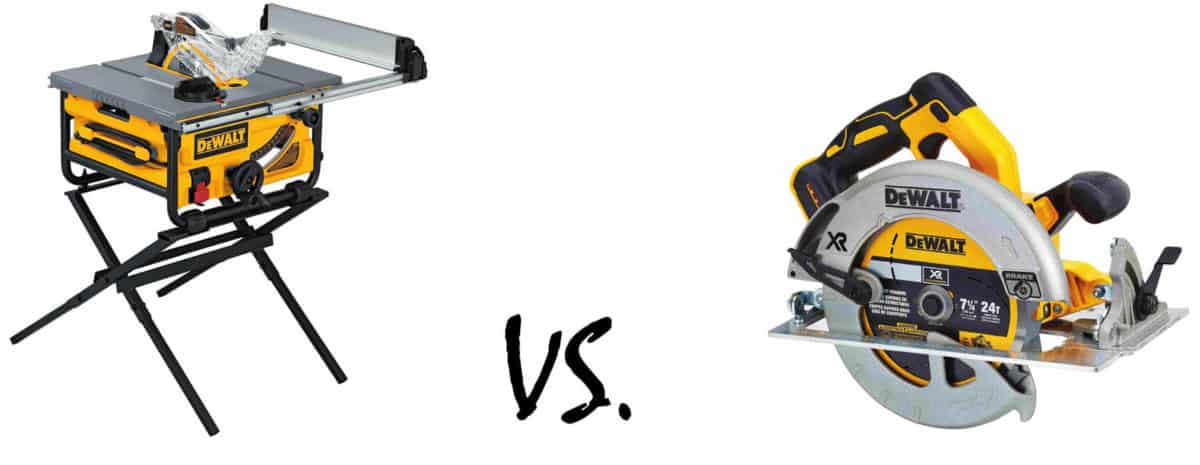
Photo credit: woodwork-made-easy.com
Table Saw vs Circular Saw
Table Saw | Circular Saw |
|---|---|
Pros | Pros |
Cons | Cons |
Best for | Best for |
Best used for larger projects. This tool allows for consistency in large and repetitive cuts. | Best used as a hand saw. This is a versatile tool that is great for smaller cuts. |
What is a Table Saw?
A table saw is a type of power tool that features a circular blade that cuts along a horizontal line. This saw has a stationary blade mounted on the table. To cut wood, you must push the material through the blade. If the saw does not have a table attached, it must be placed on an external table or stand to be operational.
People often use table saws for woodworking, but you can also cut other materials such as plastic, acrylic, tile, or metal. Often, table saws are featured on construction sites or industrial workplaces. However, they are also regularly used in homes and hobby shops.
Many different types of table saws are available. A table saw usually has a circular saw, an arbor, a table, a fence, and an electrical motor. Some include various components, such as feather boards, miter gauges, and push sticks, and you can add different blades to the saws to cut a variety of materials.
A good table saw is determined by its performance and quality. Most good quality saws have high rip capacities, adjustability of the fence and gauge, powerful motors, a high level of RPMs, and will be made out of durable materials.
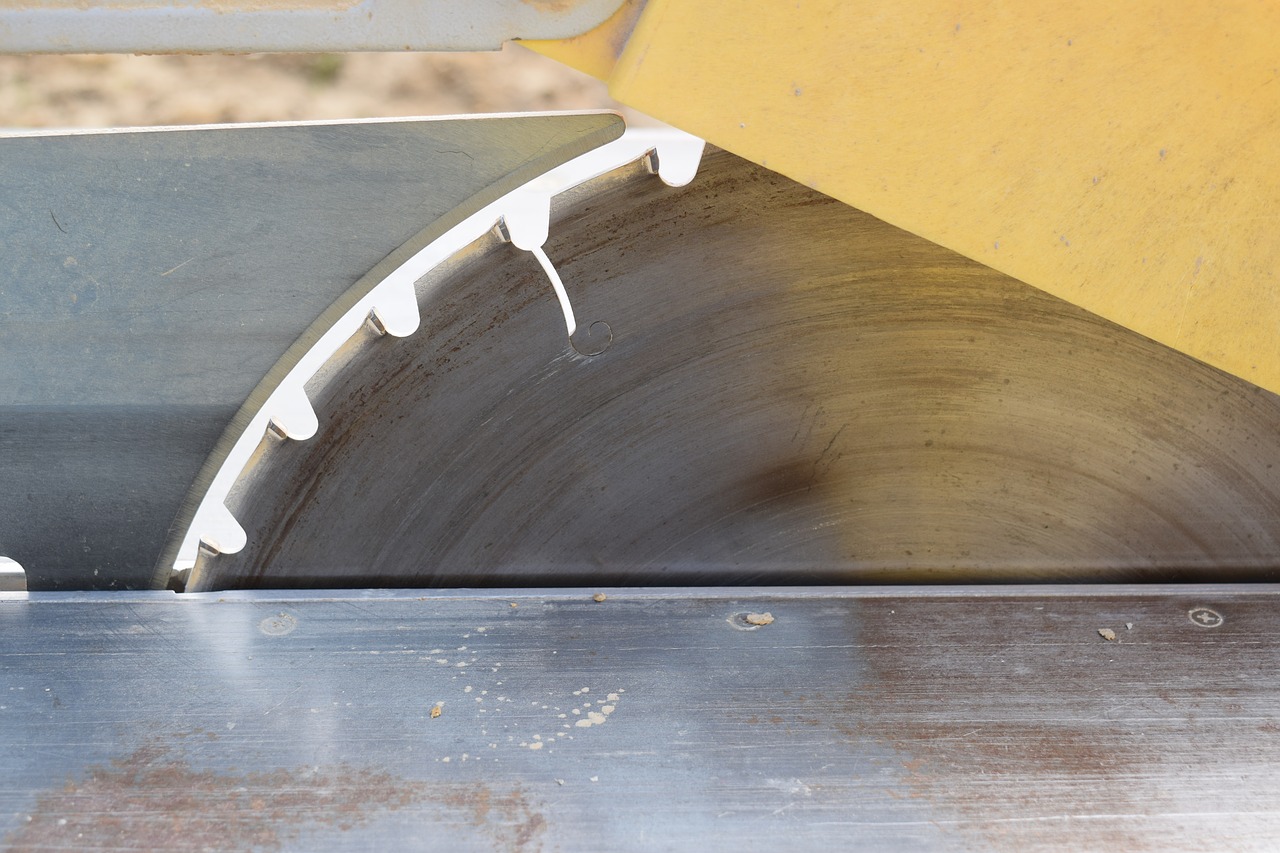
What is a Circular Saw?
A circular saw is a category of saw featuring a circular blade that cuts by spinning rapidly. A table saw is a type of circular saw. Other common circular saws include miter saws, radial arm saws, sawmills, brush cutters, and biscuit joiners. In this case, the term circular saw is being used to refer to a handheld circular saw. When the term is used without specification, this is usually the sense in which it is being used.
A handheld circular saw is essentially a powered handsaw. It was invented to make cutting much faster, easier, and more precise. As anyone with experience with a manual hand saw will know, cutting large amounts of wood by hand is an incredibly demanding task.

Photo credit: woodworkingtalk.com
Like the table saw, a handheld circular saw is generally used to cut wood. This is commonly the case when used on construction sites, in homes, and by hobbyists. However, these saws can also be used for various other materials such as metal, acrylic, and tile. These other materials require special blades that feature the correct tips. A saw might be used in this way by an HVAC specialist, a sheet metal worker, or a contractor.
Relevant Characteristics Between Table Saws and Circular Saws
Table Saw | Circular Saw | ||
|---|---|---|---|
110 or 220 | Voltage | Varies (60, 20) | |
600-2,400 | Wattage | ~900 | |
3,500+ (Max very high) | RPM | 3,000-7,000 | |
10+ years | Lifespan | 10+ years | |
Up to ~4’x8’ | Length of Cut | Unlimited | |
Similarities and Differences
Now that the basic stats are out of the way, we can get into some of the more extensive analysis.
In many ways, these two circular saws are closely related. However, there are many differences between a table saw and a circular saw. Here’s a look at the key differences:
Table Saw and Circular Saw Differences
As is clear, there are some significant differences between table saws and handheld circular saws. These differences become evident immediately. For instance, one of the largest and most significant differences between these two pieces of equipment is that the table saw is a stationary tool. In contrast, the handheld saw is a small, portable tool. You bring handheld saws to the material. When it comes to table saws, you bring the material to the saw.
To use a table saw, you push the material through the spinning blade, and the table setup directs the cut. To plan a cut, the operator must measure the material and then set the fence and gauge accordingly. The cut itself is very low effort. After being set, you can make the same cut again and again.
To use a handheld circular saw, the operator must push the saw through the material, which means that the operator directs the cut. They must measure the material, mark the cut, and then carefully follow through. While this allows for a significant degree of control, it also means that the cut will take more skill and technique.
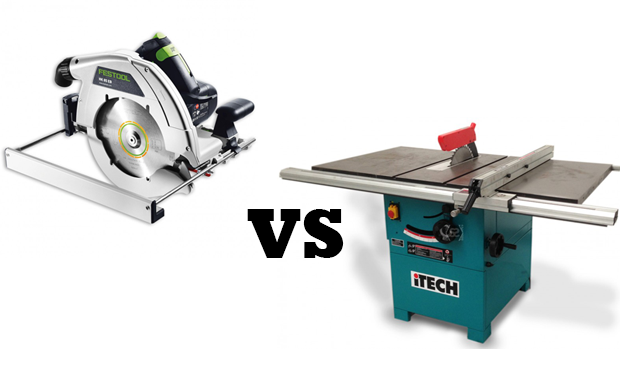
Photo credit: powersawexpert.com
https://woodworkadvice.com/saws/table/types/Table saws make large scale cuts. These cuts are, at the most basic level, straight and consistent. They are intended to make larger projects easier. Using a tool that allows the operator to cut across a straight line, the operator can save themselves a huge amount of effort. The table saw makes measurement, technique, and planning much more efficient.
Handheld saws are used in much the same way as a handsaw. These saws make smaller projects much more efficient. Rather than exerting a huge amount of energy and time to a single cut, a handheld circular saw allows the operator to cut quickly and cleanly. However, these saws do not have the same degree of precision as a table saw as they do not feature a guide or fence.
Table Saw and Circular Saw Similarities
Though the differences seem stark, there are quite a large number of similarities between these two pieces of equipment.
Some of the similarities between the table saw and a handheld circular saw are very evident. For instance, both of these power saws are forms of a circular saw. As a result, they both feature a circular saw blade that cuts by spinning. Though a handheld saw cuts by passing through the material, and a table saw cuts by passing the material through the saw, the basic cutting mechanism is the same.
Also, both table saws and handheld circular saws can make many of the same cuts. You can use these saws to perform rip cuts, cross cuts, trims, and angled cuts. To make these cuts on a table saw, you can install a miter gauge or a sled. With a handheld saw, you need precision and expertise.
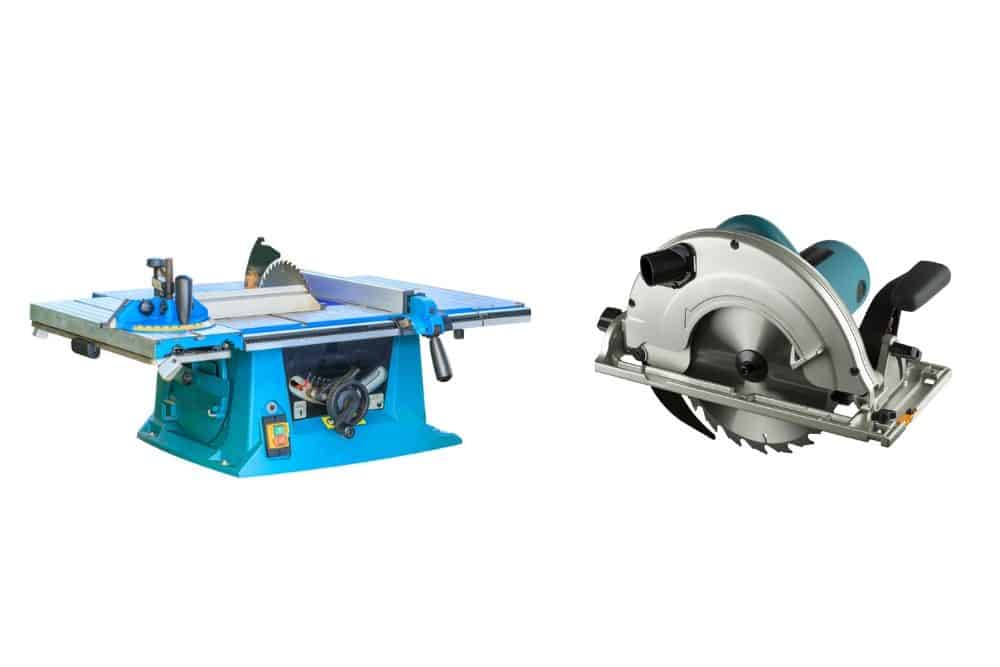
Photo credit: thedailygardener.com
People use both table saws and handheld saws for carpentry, woodworking, and other wood-based construction methods. However, you can adapt the saw with special blades for use with other materials. As a result, these tools are prominent in industrial and construction sites across a range of fields.
For the most part, these tools have similar functions. Despite their apparent differences, they also have very similar mechanisms internally. The primary difference in mechanism is not to do with the motor, gear assembly, or belt drive, but with the amount of power and the capacity of the saws. A handheld saw often features the same set up as a table saw in terms of blade control. Therefore, the handsaw can sometimes be understood as a portable and lighter version of a table saw.
Advantages of Table Saws
If you plan to work on any major home improvement project, you will likely need to make use of a table saw at some point. If you don’t use one personally, it is almost certain that someone else will use one for you because table saws are one of the best tools out there for ripping large pieces of wood to create short planks, boards, or to cut a piece of lumber to size.
When making large scale straight cuts, there is still no better tool than a table saw for the job. A track saw might allow for consistent straight cuts over long distances but does not typically feature a fence, miter gauge, or specifically designed cutting surface. These features mean the table saw operator has to adjust the preset dimensions and guide their material through the saw. This process enables extremely precise cuts. It also allows the operator to make the same cut time and time again.
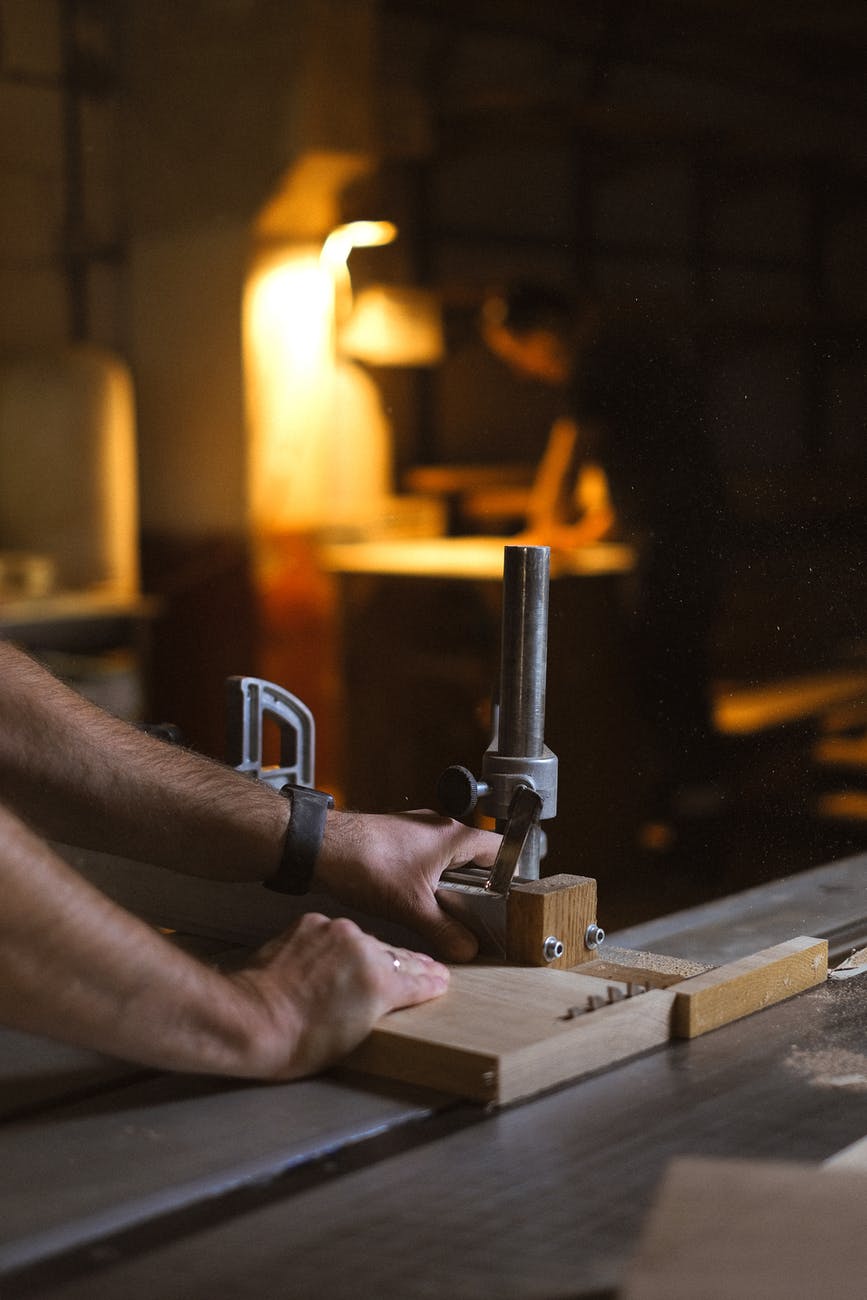
A good table saw should have a strong rip capacity, a powerful motor, a reliable and sturdy table or stand, and a good degree of adjustability to allow for variance in cut depth and length. Some table saws will even allow for angular blade adjustments, making angled cuts possible. Having a saw with these features makes the difference between a lower lever saw and a top-shelf piece of equipment.
The advantages of a quality table saw include sufficient power, portability, storage, adjustability, and durability. A quality table saw will feature an adjustable fence, holding your wood in place as you push it through the saw blade, which allows the cut to remain clean and straight regardless of the length. In contrast, a hand saw requires incredible consistency to ensure straightness over distance.
Advantages of Circular Saws
As mentioned earlier, we often use the term circular saw when referring to a handheld saw. A circular saw is a type of power saw. Miter saws, table saws, and brush saws are circular saws. The advantages of these saws vary depending on their specific usage.
There are many advantages to a handheld circular saw. People usually use these saws to cut wood, and you can use them to cut other materials, too. These materials include metal, plastic, acrylic, masonry, and tile. To do so, it is necessary to attach the correct saw blade. The advantages of this are that the saw itself can be used for a wide range of tasks. Saw blades can simply be switched out and stored.
Handheld saws are very common. For the most part, everybody has a hand saw in their garage, shed, or toolbox. The reason is that there are simply times that they are necessary. A handsaw is far more likely to be used regularly when doing minor woodworking than either of the other saws mentioned. They are great, in particular, for crosscuts.
A handheld circular saw is a more advanced, powered version of a handsaw. These saws are more efficient, more powerful, and more precise cutting tools. As anyone who has substantial experience with carpentry knows, a handsaw can be a difficult tool to use. Though it is simple, the saw takes time and effort to work through materials. In contrast, a handheld circular saw takes almost no effort to push through the wood. They are incredibly handy when you are taking on smaller jobs. For example, they can be used to trim boards and planks, cut lengths of wood, and cutting slots and rebates.

What About Miter Saws?
Another common type of circular saw is the miter saw. The miter saw largely replaced the radial arm saw when it was invented in the 1970s. Radial arm saws were intended to make horizontal cuts easier. The miter saw features a circular saw blade mounted on an arm that hangs above the table. To cut, you bring the saw blade down to the material. If the miter saw is a compound model, it may also feature a radial guide to allow the saw to cut horizontally and vertically.
Miter saws tend to be used most often when making shortcuts, angles, bevels, or crosscuts. This saw allows the operator to make these cuts with ease as the saw blade is manually adjustable even while in use. As a handheld saw, the miter saw blade attaches to a handle that is brought to the material. It can usually be tilted and angled as the cut is in process, allowing for specialty cuts such as bevels. It is likely one of the most precise saws out there.

Photo credit: finepowertools.com
The advantages of a miter saw are significant. One of these advantages is that a beginner or amateur woodworker can produce very high-quality work because intricate and detailed cuts that would be unimaginable for a beginner with a handsaw or a table saw are made much more simple when guided by the machinery. Also, a miter saw uses a downward motion that allows for a very high degree of visibility for the operator. This means that the amount of control possible is quite high.
When using a miter saw, the cuts are short and quick, which means that there is no risk that a change in angle, pressure, or speed will result in an uneven cut. The drawback of this is that there is little opportunity to make longer cuts.
When and Why Would I Use a Table Saw?
You are unlikely to have any shortage of opportunities to use a table saw. Table saws can be used for most cuts that can be performed with other saws. For instance, the table saw can handle precise and intricate line work with the correct attachments. However, this will likely take a lot of practice. For this reason, table saws are hugely versatile. Specialty cuts simply require a little more expertise than they might on another saw.
Here are some of the things that table saws do best:
Large Cuts
If you’re planning to cut a large piece of wood, whether you’re ripping a long piece of plywood, or cutting through a thick piece of lumber, a table saw is the best tool available.
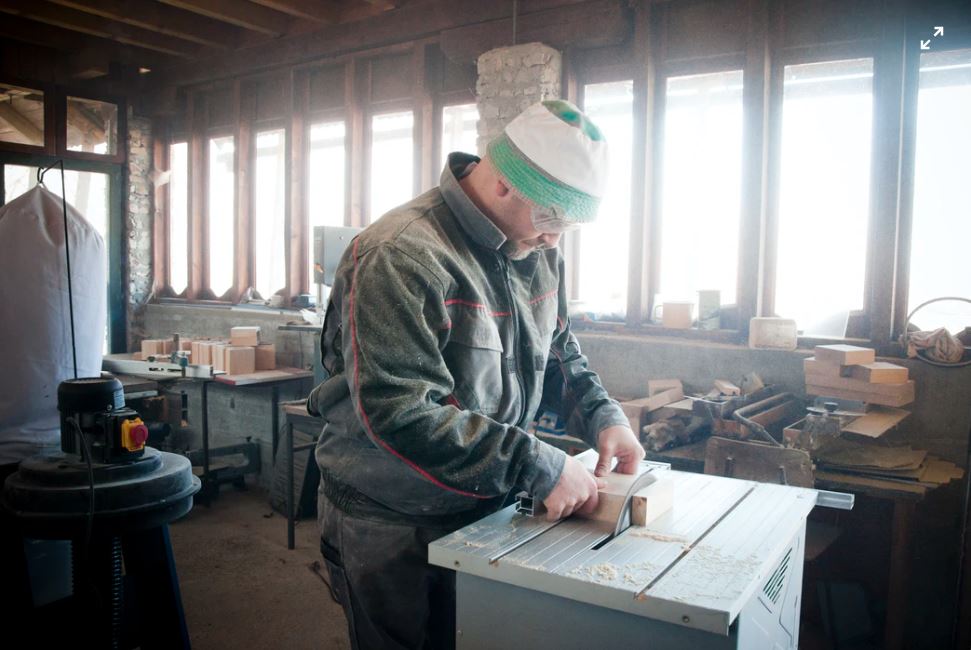
These saws can handle wood of almost any length and can maintain consistency over the distance.
Straight Lines
For straight cuts, the table saw is the best tool. A hand saw is great for making shorter cuts and trims jobs. However, a table saw allows you to make much straighter cuts due to the fences and guide.
Versatility
In the hands of an expert, these saws can make almost any cut. It just might not do it as easily.
When and Why Would I Use a Circular Saw?
In essence, a handheld circular saw can be used for any job that you would normally use a manual handsaw for. The benefit of a circular saw is its efficiency. These saws cut faster, more cleanly, and more powerfully than their manual alternatives. As a result, you will not have any difficulty finding jobs for a handheld circular saw either.
Here are some of the things that a handheld circular saw can do best:
Shorter Jobs
If you are just cutting the end off a 2x4 to make it fit the dimensions of a certain project, there is no sense in setting up a table saw. Instead, a handheld saw can make short and easy work of it.
Precise Work
If you need a large degree of control over your cuts, it is best to use a handheld saw. This is because you can manually adjust as you cut. It is also possible to feel out the board.
Crosscuts
A table saw is excellent when you need to rip wood. For cross cuts, however, you might have to add a sled to the saw. With a handheld circular saw, however, crosscuts are quick and easy.
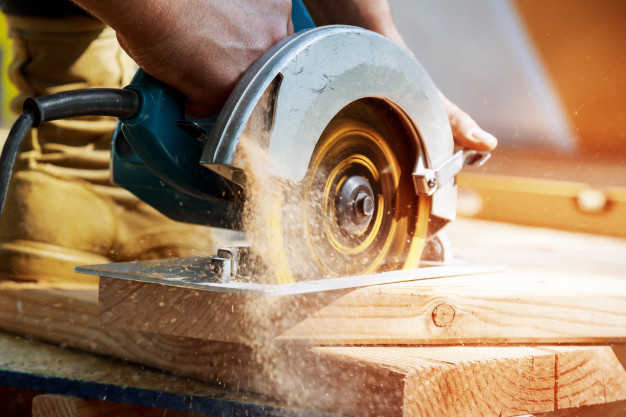
Bottom Line
At the end of the day, both handheld circular saws and table saws are great tools. They simply have different uses. Both saws are intended to make the construction process faster and easier.
If you are planning to make a lot of small cuts and need a large amount of flexibility, a handheld circular saw may be better suited to your needs.
In contrast, if you are planning to make larger cuts and are going to be working with more substantial pieces of material, a table saw may be better suited to your needs.
People Also Ask
Now you know everything there is to know about the table and circular saws... or, should we say, table saws and handheld circular saws.
Before you go, take a moment to read through some of our answers to commonly asked questions regarding the differences between circular saws and table saws. This FAQ should clear up any questions that we’ve left unanswered.
Can a Circular Saw Be Used as a Table Saw?
A table saw is a form of a circular saw. A handheld circular saw can be used similarly to a table saw; however, it does not have a surface or fence. As a result, guiding the cut in a straight line is far more difficult than it is on a table saw.
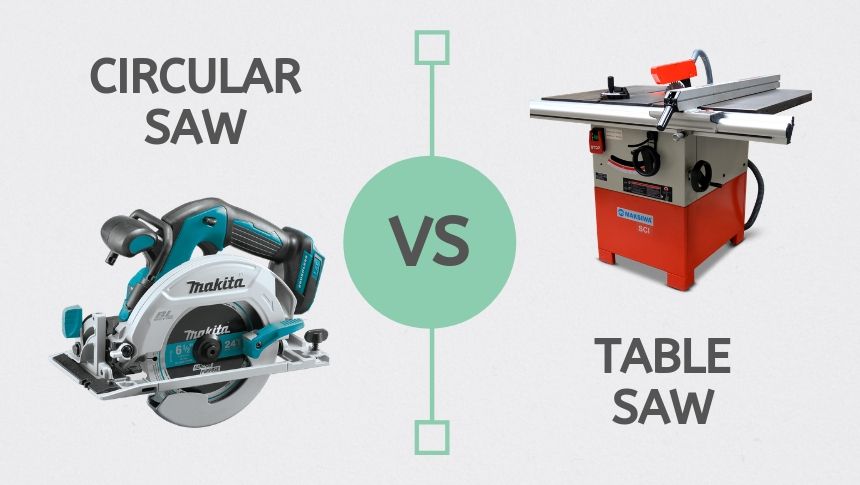
Photo credit: sawview.com
Is a Circular Saw Safer Than a Table Saw?
Not necessarily. It is also not more dangerous. A handheld saw is used differently from a circular saw. As a result, it requires different safety precautions. It is important to always operate the saw with care and proper technique to ensure that it functions safely and effectively.
Why Does My Circular Saw Not Cut Straight?
A circular saw can cut straight. Handheld circular saws are more difficult to use to cut a straight line because they do not have guide rails, fences, tabletops, miter gauges, or other accessories intended to direct the cut. Therefore, a change in pressure or direction, no matter how slight, can cause an imprecise cut.
How Long Does a Circular Saw Last?
The length a saw will last for is dependent on the saw itself. A good quality saw should last you for approximately ten years before it needs replacement. At this time, the blades will need to be replaced occasionally. Some saws will last far longer, and lower quality saws may last for just a year or two.
